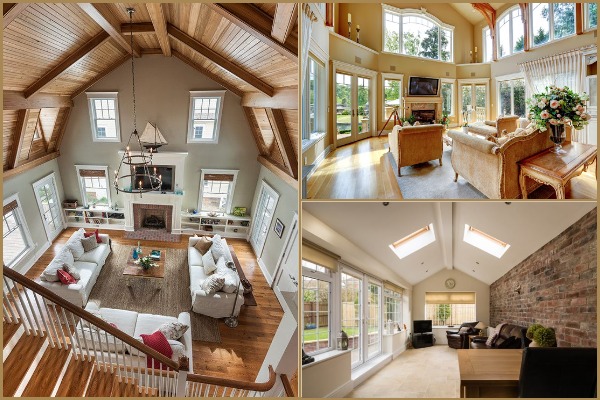You know how you want to decorate your walls. You have big plans for sprucing up your floors.
But do you have an idea how you’re going to show off your fifth wall? If you’re not sure whether you’ll go for a faux stone ceiling or having ceiling beams painted in a contrasting shade, don’t worry.
You can find tons of inspiration online, and for sure you’ll find one that suits your aesthetic. Before you focus too much on that, though, make sure you’ve thought about the right ceiling height for your new home construction or remodeling project.
That being said, let’s help you figure out the best ceiling height for your house.

Do Tall Ceilings Look Bigger?
If your major concern is “how to make my house look bigger,” then go for a high ceiling.
With tall ceilings, it’s easier for living spaces to give off a more spacious, airy vibe. Having a high ceiling is also a simple way to add grandeur to staircases, entryways, living rooms, and so on. Plus, if you pair a tall ceiling with bigger windows, you get the extra benefit of letting more natural light into your home.
Also Read: Modern Home Office Ideas to Enhance Your Office Space
Take note, however, that higher ceilings cost more to build. All that extra space also means you’ll pay more for heating and cooling, not to mention, you must go bigger with your furniture and other decorations so as not to throw off the rooms’ proportions. Meanwhile, low ceilings can make rooms look cozier and warmer.
They’re also best for rooms where noise can be an issue, such as bedrooms or game rooms. The main downside, though, is the risk of spaces looking cramped. But there are some tricks to counteract this, like using vertical patterns on walls, stretching the space with curtains, etc.
Deciding on the Right Ceiling Height
Going lower or higher with your ceiling isn’t 100% entirely up to you. There’s a standard set by the International Residential Code (IRC).
For living rooms, kitchens, and bedrooms, the standard ceiling height is 9 feet. If your home will have a second floor, 8 feet is the standard. In luxury homes, it’s not uncommon to have higher ceilings, reaching up to 12 feet.
Now, if you want varying ceiling heights, it’s best to talk to your builder, especially if you’re not going for a traditional flat ceiling. There are spatial and structural considerations for sloped, coffered, tray, or vaulted ceilings, and you need to sort these out before beginning construction.
For a remodel, don’t forget to schedule a roofing inspection first. You’ll want to know the condition of your interior ceilings and attic before raising ceiling height.
Look Up and Smile
Now that you have some idea on how to choose the right ceiling height for your home, are you picturing how your new ceilings will look like?
If yes, great. Once your ceilings are done, you’ll have more reason to look up and just enjoy the view.
Also Read: 5 Advantages of Living in a Waterfront Property
For more design tips for houses, check out our other posts.